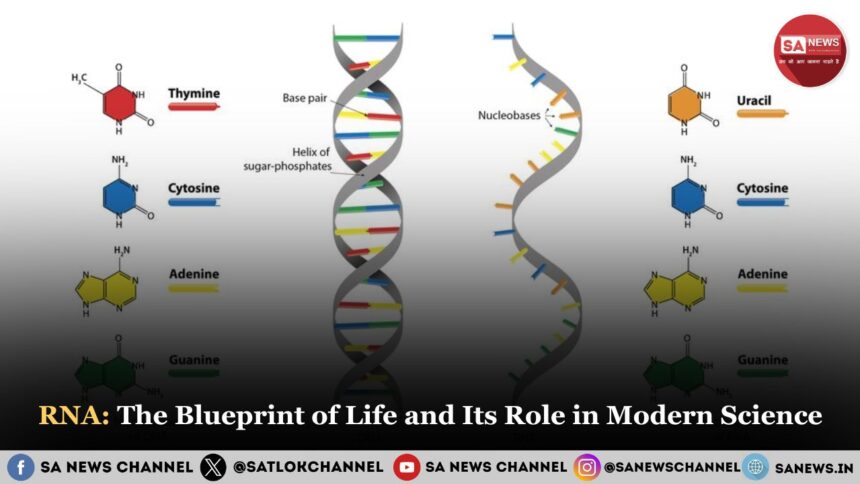Ribonucleic Acid (RNA) is one of the fundamental molecules of life. RNA serves as a link between DNA and the production of proteins, playing an essential role in gene expression, regulation, and viral processes. Recent advancements in RNA-based therapies, such as mRNA vaccines, have revolutionized medicine. Understanding RNA provides insights into cellular function, disease treatment, and evolutionary biology.
- Discovery and Historical Significance of RNA
- Structure and Types of RNA
- Functions of RNA in Cellular Mechanisms
- Protein Synthesis
- RNA in Genetic Regulation
- RNA and Evolution
- Ribozymes – Catalytic RNAs
- RNA in Medicine
- RNA in Diagnostics
- RNA Splicing and Alternative Splicing
- RNA’s Role in Viruses
- RNA vs. DNA
- Modern Research on RNA
- RNA Vaccines
- RNA Interference (RNAi)
- Synthetic RNA Therapies
- Challenges in RNA Research and Therapy
- Ethical and Social Dimensions
- RNA in the Human Genome
- Conclusion
- Satgyan Insight on RNA
- FAQs on RNA
- 1. What is the full form of RNA?
- 2. How is RNA different from DNA?
- 3. What is the function of mRNA?
- 4. How do RNA vaccines work?
- 5. Can RNA be used for gene editing?
- 6. Why is RNA less stable than DNA?
- 7. What is the RNA world hypothesis?
- 8. Can RNA viruses be treated effectively?
- 9. Are RNAs harmful to humans?
- Connect With Us on the Following Social Media Platforms
Discovery and Historical Significance of RNA
The journey of RNA discovery began in the 19th century when Friedrich Miescher first identified nucleic acids. However, its true significance came to light in the 20th century with the discovery of messenger RNA (mRNA) by François Jacob and Jacques Monod in 1961. The subsequent development of the central dogma of molecular biology (DNA -> RNA -> Protein) by Francis Crick further established RNA’s crucial role in genetic processes.
Structure and Types of RNA
RNA Structure
RNA is a single-stranded molecule made up of ribonucleotides, which consists of:
- A phosphate group
- A ribose sugar (Unlike DNA, which has deoxyribose)
- Nitrogenous bases (Adenine, Uracil, Cytosine, Guanine)
Types of RNA
- Messenger RNA (mRNA) transmits genetic information from DNA to ribosomes.
- Transfer RNA (tRNA): Helps in decoding mRNA during protein synthesis.
- Ribosomal RNA (rRNA): Forms the structural component of ribosomes.
- MicroRNA (miRNA): Regulates gene expression.
- Small Interfering RNA (siRNA): Involved in gene silencing.
- Long Non-Coding RNA (lncRNA): Plays roles in gene regulation and chromatin modification.
- Circular RNA (circRNA): Recently discovered non-coding RNA that forms loops and acts as miRNA sponges and biomarkers in diseases.
Functions of RNA in Cellular Mechanisms
Protein Synthesis
RNA plays a crucial role in converting DNA instructions into active proteins.The process involves:
- Transcription: DNA is copied into mRNA in the nucleus.
- Translation: Ribosomes use mRNA to build proteins with tRNA assistance in the cytoplasm.
RNA in Genetic Regulation
Non-coding RNAs (miRNA, siRNA) help in controlling gene expression by silencing certain genes or modulating protein production. This regulatory function is crucial in development, immune responses, and even cancer suppression.
RNA and Evolution
The “RNA world hypothesis” suggests that early life forms relied on RNA for genetic information before DNA evolved. This theory is supported by the self-replicating ability of some RNA molecules.
Ribozymes – Catalytic RNAs
Some RNA molecules, called ribozymes, act as enzymes to catalyze chemical reactions. This discovery supports the idea that early life could rely solely on RNA for both genetic storage and metabolic functions.
RNA in Medicine
- mRNA Vaccines (e.g., COVID-19 vaccines): Teach cells to produce viral proteins, stimulating immune responses.
- RNA-Based Therapies: Used in treating genetic disorders and cancers.
- CRISPR and RNA Editing: Scientists can edit genetic sequences using RNA-based mechanisms, offering hope for genetic diseases.
RNA in Diagnostics
RNA is used in molecular diagnostics such as RT-PCR tests to detect viral RNA (e.g., SARS-CoV-2). Gene expression profiling using RNA helps in early detection of cancer and other diseases.
RNA Splicing and Alternative Splicing
Before mRNA becomes functional, it undergoes splicing to remove introns and join exons. Alternative splicing allows a single gene to produce multiple protein variations, increasing protein diversity and regulating cell functions.
■ Also Read: Analysis of a DNA with TwigStats
RNA’s Role in Viruses
Certain viruses, like HIV and coronaviruses, use RNA instead of DNA. They hijack host cells using reverse transcription (RNA to DNA), leading to diseases. Some well-known RNA viruses include:
- Influenza Virus
- HIV (Human Immunodeficiency Virus)
- SARS-CoV-2 (COVID-19)
RNA vs. DNA
| Factor | RNA | DNA |
| Function | Protein synthesis, gene regulation | Genetic storage |
| Sugar | Ribose | Deoxyribose |
| Bases | A, U, C, G | A, T, C, G |
| Structure | Single-stranded | Double-stranded |
| Location | Cytoplasm and nucleus | Mainly nucleus |
Modern Research on RNA
RNA Vaccines
A breakthrough in immunology, mRNA vaccines have played a key role in controlling COVID-19. Scientists are now exploring mRNA vaccines for diseases like malaria and cancer.
RNA Interference (RNAi)
siRNA and miRNA-based drugs are being developed to target genetic disorders. These technologies silence faulty genes and help in treating complex diseases.
Synthetic RNA Therapies
Researchers are developing synthetic RNA-based drugs for neurological disorders like Alzheimer’s and Parkinson’s. These therapies aim to correct gene expression and restore normal cellular function.
Challenges in RNA Research and Therapy
- Instability: RNA is vulnerable to breakdown and requires protective delivery methods.
- Delivery: Ensuring accurate targeting without immune system activation remains a challenge.
Ethical and Social Dimensions
Gene editing using RNA (e.g., CRISPR) raises ethical concerns around designer babies, consent, and unintended effects. It’s essential to have regulations for safe and responsible use.
RNA in the Human Genome
The human genome contains genes that code for both proteins and non-coding RNAs. RNA is involved in:
- Gene regulation
- Protein synthesis
- Ribosome function
Conclusion
RNA is more than just a molecule; it is the essence of biological processes. Its role in genetics, medicine, and evolution underscores its significance. Understanding RNA provides insights into disease mechanisms, potential treatments, and the fundamental processes of life. With the rapid advancement in RNA-based technologies, the future holds immense potential for medical innovations and scientific discoveries.
Satgyan Insight on RNA
RNA’s complex roles in life processes like protein synthesis show intelligent design—not random evolution. Satgyan reveals that such precision is the work of Supreme God Kabir, the true Creator.
The micro world (like RNA in the body) and the macro world (universe) are both created by the same Supreme God Kabir Saheb, who reveals all secrets through true spiritual knowledge.
The “RNA world” theory assumes life began from molecules, and Tatvagyan says creation began through God’s divine will—not chemicals. Ribozymes (RNA with enzyme-like activity) further reflect God’s engineering in creation.
Science focuses on body functions, but true purpose of life is to attain salvation, not just survive. RNA may sustain the body, but only Satgyan and Naam Diksha from a true Tatvadarshi “Sant Rampal Ji Maharaj Ji” can free the soul from birth-death cycles. Visit Saint Rampal Ji Maharaj Ji YouTube channel for more information.
FAQs on RNA
1. What is the full form of RNA?
RNA stands for Ribonucleic Acid.
2. How is RNA different from DNA?
RNA is single-stranded, contains ribose sugar, and uses uracil instead of thymine. DNA is double-stranded and more stable.
3. What is the function of mRNA?
mRNA carries genetic instructions from DNA to ribosomes for protein synthesis.
4. How do RNA vaccines work?
RNA vaccines introduce synthetic mRNA to instruct cells to produce a viral protein, triggering an immune response.
5. Can RNA be used for gene editing?
Yes, technologies like CRISPR use RNA to target specific genes for modification.
6. Why is RNA less stable than DNA?
RNA has an additional hydroxyl (-OH) group in its sugar structure, making it more susceptible to degradation.
7. What is the RNA world hypothesis?
It is a theory suggesting that life originally evolved using RNA as the primary genetic material before the advent of DNA-based life forms.
8. Can RNA viruses be treated effectively?
Some RNA viruses have vaccines or antiviral treatments, but their high mutation rates make them challenging to control.
9. Are RNAs harmful to humans?
Mutant ribonucleic acid (RNA) molecules can be toxic to cells, causing human diseases through dominant-negative mechanisms.









